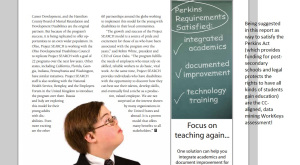
Before we look at how Common Core via the Career Tech Education has impacted “Alternative Education”, we need to know how “AE” is defined. So, for that, I’m using the U.S. Dept. of Education’s Research Report “How Do the States Define Alternate Education?” (I must cite it as the following: Porowski, A., O’Conner, R., & Luo, J. L. (2014). How do states define alternative education?(REL 2014–038). Washington, DC: U.S. Department of Education, Institute of Education Sciences, National Center for Education Evaluation and Regional Assistance, Regional Educational Laboratory Mid-Atlantic. Retrieved from http://ies.ed.gov/ncee/edlabs.)
According to the Report’s Summary, “Alternative education programs—broadly defined as educational activities that fall outside the traditional K–12 curriculum—frequently serve students who are at risk of school failure. Because individual states or school districts define and determine the features of their alternative education programs, programs may differ in key characteristics, such as target population, setting, services, and structure.” The Report goes on to share that depending on the State, legislation may have differing definitions. For example, only 43 States and the District of Columbia have formal definitions of what alternative education is. Things considered that need to be clarified are what age groups are being targeted? Are the alternative education programs to serve those with special needs? Will there be other services provided like anger management, counseling, etc. Will the alternative education be separated from the more traditional education or will it be included among the more traditional settings?
A bit further into the Report, this definition of what alternative education can be defined as is cited, “Alternative education programs—broadly defined as educational activities that fall outside
the traditional K–12 curriculum—include home schooling, general educational development
(GED) programs, gifted and talented programs, and charter schools (Aron, 2006).”
*NOTE: If you’ve been following my blog long, you know I’ve already addressed how the GED is now aligned to Common Core and how charters, home education are finding Common Core Standards in their choices as well. If you haven’t been following for long, please be sure to use the search feature.
A federal definition of alternative education was included in the Report, “At the federal level an alternative school is defined as “a public elementary/secondary school that addresses needs of students that typically cannot be met in a regular school, provides nontraditional education, serves as an adjunct to a regular school, or falls outside the categories of regular, special, or vocational education” (Sable, Plotts, & Mitchell, 2010, p. C-1). This definition does not address alternative education programs within schools.”
The Report goes on to state that ‘Alternative Education’ has changed. Curriculum and content have been aligned to meet specific needs or goals. This means it drives the approach to the students. You’ll want to look at the tables included to see where your State lands,
http://ies.ed.gov/ncee/edlabs/regions/midatlantic/pdf/REL_2014038.pdf
What CTE means for “Alternative Education”:
According to a special report from the Association for Career and Technical Education on Drop Out Students,(see: www.acteonline.org/WorkArea/DownloadAsset.aspx?id=2094) The Dropout Prevention Center/Network notes that CTE (Career Tech Education) is one of its 15 solutions or strategies. The Center/Network believes “such as individualized instruction, service-learning, community collaboration, mentoring, active learning, and educational technology. According to the Center, “A quality CTE program and a related guidance program are essential for all students.” CTE was identified to have five potential benefits to at-risk students by Schargel and Smink in Strategies to Help Solve our School Dropout Problem. These benefits include enhancement of students’ motivation and academic achievement; increased personal and social competence related to work in general; a broad understanding of an occupation or industry; career exploration and planning; and acquisition of knowledge or skills related to employment in particular
occupations or more generic work competencies.” The Association for Career and Technical Education’s Report for Students With Special Needs, titled “Transitioning Students with Special Needs into Work” (see:
Transitioning-Students-with-Disabilities-into-Work). In the picture below, be sure to enlarge it by clicking on it. CTE is dependent upon the WorkKeys assessment (which has been shown in print and video here on my blog and others to not only be Common Core aligned, but a massive data mining tool as well)
Regardless of how your student may be considered as ‘alternative’, some truths remain the same:
1) All CTE is Common Core/Workforce aligned. (refer back to any of my Thursday posts)
2) You’ll be eligible for a “Certificate”, a “Certification”, a “License”, or a “Degree”.
3) You will be assessed multiple times and at some point need to use the WorkKeys assessment which will assign a national number. Many employers will not consider you without that national number.
4) Because Career Tech Ed has 16 clusters, you will be inserted into someone’s ‘talent supply pipeline.’
5) One of CTE’s biggest reasons for existing: Driving America’s competitiveness in the ‘global economy’.
(see: Competitiveness)
Project Search:
This program was referenced in the resources from the Assoc. for CTE (above) as a business led model for those students with special needs. Being heralded as a great P3 (Public, private partnership) look at the involved groups,
- Businesses
- Education / Schools
- Vocational Rehabilitation
- Community Rehabilitation Providers
- Long-term Support Agencies
- Families
- Social Security Administration (see the entire Program Model website page: http://www.projectsearch.us/OurPROGRAM/ProgramModel.aspx )
Below is a “Project Search” promo video. When you view it, please consider all that you see and hear through the lenses of Common Core aligned CTE. Since this video has been made and released the State Superintendent for Public Instruction (VA), Mary Wright has retired and Steve Sharp in now overseeing VA’s Public Instruction. He recently approved over $1 million dollars to be used for CTE equipment. (see: http://www.doe.virginia.gov/administrators/superintendents_memos/2014/201-14.shtml)
[youtube https://www.youtube.com/watch?v=UQ-8p5DN26c&w=560&h=315]
Here’s a short video about one of the ‘certificates’ available to our students courtesy of WorkKeys. Notice the “Workforce” Ready logos strategically placed throughout the settings. Again, view through the lenses of Common Core, CTE.
How I Know Common Core and CTE are related:
One of the earliest websites I discovered when embarking on research to track down Common Core beyond high school is http://www.careertech.org/CCTC Even when you look at the page you’ll notice Common Core, but what you’ll realize is the shrewd placement of the two words. “Common Career Technical Core’. Once on the site, run your mouse over the second tab and you’ll see a drop down menu feature those “Career Clusters”, then look a few spaces down and bingo! “Common Core State Standards”, in living color. Want to find out where CTE is in your state? Use this link: http://www.careertech.org/cte-your-state If you go back to the main page and read their ‘fine print description’ you’ll see the misguidance of information. “State-led”, ‘rigorous’ are just two of the errors. Where you will really want to spend some time is the Common Core and CTE resource page: http://www.careertech.org/common-core-state-standards
Their stance on alternate education? This 2013 presentation supports UDL (Universal Designed Learning) for teaching all ‘special populations’ (their phrase, not mine)
http://www.careertech.org/sites/default/files/C1MahadevanUDL_AccessibletoAll.pdf (originally out of the Texas Education Administration); from Alabama, a presentation on streamlining all students into CTE: http://www.careertech.org/sites/default/files/C5MSmithcareercluster-1.pdf
California’s presentation has a total transformation of the Common Core/CTE Standards, all based on information that has been created by the Common Core Machine (meaning it is based on either CCSS supporter funding or a CCSS partner). See for yourselves how they envision all people fitting into the CCSS/CTE mold: http://www.careertech.org/sites/default/files/E2WeikleExtremeMakeoverCTEStandardsEdition%282%29_1.pdf
Consider this:
Since Common Core is a one size fits all and the definition for alternate education ISN’T, which do you think will have to bend to conform to the other? I have a guess that it won’t be the Common Core. We are hearing many stories of those outside the traditional models of education. I leave you today with this short video from my wonderful anti CC warrior friend, Gretchen Logue’s Common Core/Special Needs presentation.
[youtube https://www.youtube.com/watch?v=utrGbBZI_5w&w=560&h=315]

7 thoughts on “Tech Thursday: Career Tech/Common Core and Alternative Education”